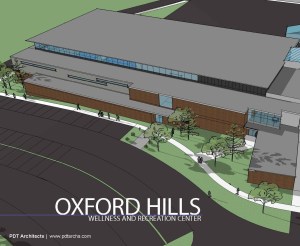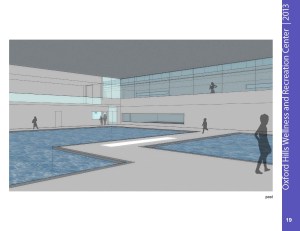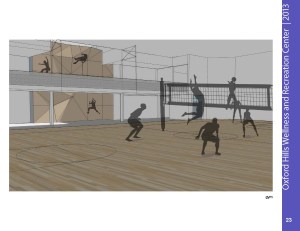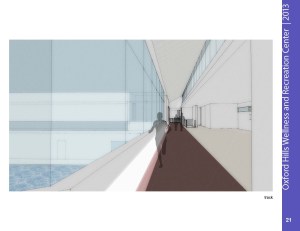OXFORD — A $12.5 million wellness and recreation center at Oxford Hills Comprehensive High School in Paris could be built if enough private funds can be raised in the next year or two, Superintendent Rick Colpitts said this week.
Colpitts and Oxford Hills Comprehensive High School Principal Ted Moccia told School Board members Monday night that a longtime dream of many to build such a facility to meet the health needs of the Oxford Hills region can be accomplished but not through the pocketbooks of local taxpayers.
“If this project is meant to be, it will be paid for outside of the tax base,” Colpitts said. “The money will be in the bank before it (construction) starts.”
The plan is to construct an Oxford Hills Wellness and Recreation Center as an addition to the high school on Route 26 in Paris. It would include a competition-size swimming pool and a smaller therapy pool, an indoor walking track, a gym and a fitness center.
The project is being spearheaded by Stephens Memorial Hospital in Norway and others concerned about the health of the Oxford Hills community. The School Board could become a partner but would not commit any public funds to the project.
The building would be owned by the school district but no school funds or taxpayer money would be used for it, Colpitts said. The center would be entirely supported and maintained with outside funding.
The school board, which represents the towns of Norway, Paris, Oxford, Otisfield, Hebron, Harrison, Waterford and West Paris, would have to give its permission to build it.
The estimated $12.5 million cost would include more than $1 million in contingency for inflation, unexpected conditions and construction change orders.
“The architect says it is possible, if you can raise the money, to build it and support it,” Colpitts said.
A Steering Committee for the project has been formed and includes Colpitts, Moccia, School Board directors Don Ware of Norway and Nick DiConzo of West Paris, hospital personnel and others.
Colpitts said the committee expects to put “feeler” letters out to prospective supporters next month. The committee will identify groups who support wellness programs, apply to the Alfond Trust fund and look for other sources of funding.
The need for a recreation center in the Oxford Hills region has been discussed for many years. About a decade ago, a survey was done to determine interest or need for a YMCA in the region.
A subsequent 76-page report found the area was not adequately served by a major recreational facility. Ninety-six percent of people surveyed at the time said the greatest need in the Oxford Hills was a recreational center and a pool to serve the youth.
By 2003, supporters of a YMCA center were looking at the C.B. Cummings & Sons Co. property in downtown Norway as a possible location. An application was made to the Rural Community Development Initiative Program for a $100,000 grant to survey the defunct dowel mill. The survey would explore, in part, the feasibility of locating a $7 million YMCA multipurpose recreation center on the 4.5 acre property. In the end, the need was there, but the funding was not, officials said.
But with reports in recent years identifying the Oxford Hills as one of the most unhealthy counties in the state, the idea kept resurfacing.
In 2012, Oxford Hills high school engineering and architectural design students presented the SAD 17 Board of Directors with four designs for a center attached to the high school. The costs were between $3.7 million and $10.6 million.
At that time, teacher John Bell said the idea was to help promote awareness of alarming health data about Oxford Hills residents that was released in 2011 following a nationwide survey of county health habits.
The students’ designs included a competition-size swimming pool, a climbing wall, cardio exercise room, strength and conditioning room, and a multipurpose room. A large lobby/cafe area serving healthy foods and drinks was also part of the design criteria.
The ideas ranged from a multipurpose gym with seating for 80 people, a regulation-size basketball court and an indoor track 14 feet above the court. An indoor track was also incorporated into some of the designs.
The students received input from the Portland Design Team, the state’s largest architectural firm, and the designer of the Oxford Hills Comprehensive High School, and others and presented their work to the School Board.
A $33,000 grant paid for Portland Design Team to draft the design plans and provide a cost analysis, Colpitts said. Those were presented to the School Board Monday night.
Do’s and Dont’s
OXFORD — Members of the Steering Committee to build a community recreation center at Oxford Hills Comprehensive High School have visited five such facilities in Maine to get input.
High school Principal Ted Moccia visited the South Portland Community Recreation Center and other facilities and said the advice was invaluable.
Topping the list of must-haves was a swimming pool, he said. The pool should accommodate swimming lessons, therapy sessions for seniors, family recreational swimming and competitive swim teams, he said.
The second major identified need was an indoor walking and jogging track for all ages, but especially for adults and seniors during the winter months. A community gym and fitness facility, and multipurpose rooms were other identified needs, he said.
Moccia said the facility managers advised the committee on a range of items. They included:
* Do build for a broad-based audience in the community.
* Don’t cut corners on pool construction because long-term maintenance and repairs could become very expensive.
* Don’t build a diving board.
* Do build well and don’t skimp on maintenance costs.
* Do have steps to enter the pool.
* Do have a main entrance.
* Do have a day care.
* Don’t build a cafe.
Operators of pool facilities stressed the importance of building a high-quality, energy-efficient enclosure for the pool area and repeatedly stressed not cutting corners on mechanical and insulation systems.
Colpitts and Moccia said the Portland Design Team engineers and architects designed a facility that could take advantage of the high school wood chip boiler for heat and hot water without a significant increase in energy costs.
Colpitts said they heard of mistakes made during construction of other facilities that cost the operators thousands of dollars later on.
“There were some horror stories of facilities that were either overbuilt or skimped on materials,” he said.




Comments are no longer available on this story